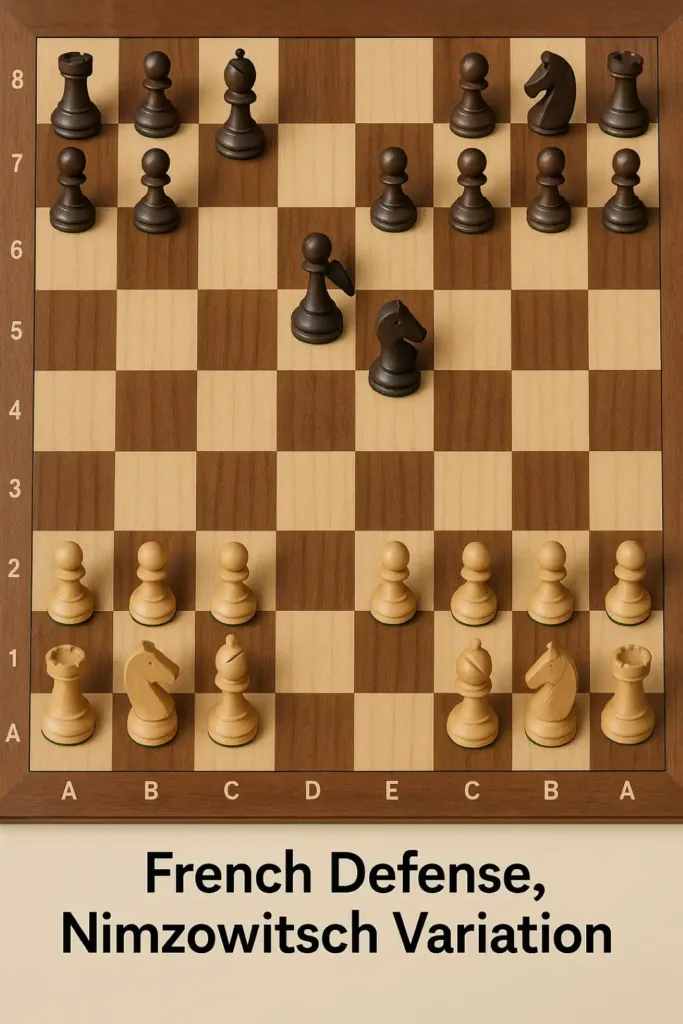French Defense Nímzovitch
The French Defense, a classical opening in chess, has long been one of the most popular and reliable strategies for black players, particularly against 1.e4. The Nímzovitch variation is one of the many subvariations within this broader defense, celebrated for its unique approach to countering white’s early moves. To understand the significance of the Nímzovitch variation, one must first explore the core principles of the French Defense itself, its key strategic ideas, and the nuances that define the Nímzovitch subvariation.
The French Defense, initially developed as a response to 1.e4, revolves around the concept of building a solid, resilient pawn structure, most notably with the advance of 1.e4 e6. The opening is characterised by a pawn chain where black immediately challenges the center and seeks counterplay through the d5 square. This setup offers a somewhat defensive structure but also opens the door to dynamic counter-attacks.
The Nímzovitch variation takes this a step further by focusing on the development of the pieces and the manipulation of white’s central control. It is an approach named after Aron Nímzovitch, one of the most prominent chess theorists of the 20th century, who contributed to refining ideas within the French Defense. This variant is known for its subtleties, often catching opponents off-guard with its indirect pawn structure and strategic positional pressure.
In a modern chess landscape dominated by chess engines, understanding the evolution and performance of the Nímzovitch variation in computer chess is crucial. This article aims to delve into the details of the French Defense, the Nímzovitch variation, its historical development, and its performance in chess computer simulations and tournaments.
The Creation and Historical Development of the Nímzovitch Variation
The French Defense itself has a long history dating back to the 19th century, with its first notable appearances in games played by prominent chess masters of the era. The Nímzovitch variation, however, emerged more recently as part of a broader effort to understand and improve the classical French Defense structure.
The first recorded use of the Nímzovitch variation can be traced to the early to mid-20th century, following Aron Nímzovitch’s deep studies into opening theory. Nímzovitch, a renowned Soviet grandmaster, made significant contributions to chess opening theory, and his variation within the French Defense was developed as an answer to white’s early central pawn structure. The move order typically begins with 1.e4 e6 2.d4 d5 3.Nc3 Nf6, leading to various ideas for both sides, but often a focus on central control and piece activity.
Nímzovitch’s innovation in this opening was based on his unique understanding of pawn structures, piece development, and timing. Instead of immediately contesting the centre with pawns, as other French Defense variations might, Nímzovitch’s approach subtly shifts the focus towards creating long-term positional pressure.
While the Nímzovitch variation was initially met with some resistance, its flexibility and strategic depth eventually won it significant recognition, particularly among players who valued subtlety and long-term planning. Over time, it became an integral part of the broader French Defense repertoire, adopted by players at all levels, including world champions and grandmasters.
The advent of computer-assisted analysis has also played a role in reshaping the understanding of the Nímzovitch variation. Chess engines have examined positions in the variation exhaustively, revealing deep lines of play that were not previously understood. The modern computer revolution has solidified Nímzovitch’s place in the opening’s theoretical landscape, offering players fresh insights into its merits and potential drawbacks.

Results with Black: The Nímzovitch Variation in Chess Computers
The performance of the French Defense, specifically the Nímzovitch variation, with black in the realm of computer chess is a crucial aspect of evaluating its strength and viability. To assess this, we turn to two major resources for computer chess statistics: the Computer Chess Rating Lists (CCRL) and the Top Chess Engine Championship (TCEC).
Performance Data from the CCRL
According to the CCRL (source: Computer Chess Rating List), black’s performance in the Nímzovitch variation is typically assessed based on its results against the various chess engines. The variation is known for creating balanced yet dynamic positions that often result in solid yet slightly passive positions for black, with a strong emphasis on counterattacking rather than direct confrontation. The statistics reveal that black tends to score well in the opening, particularly in rapid and blitz formats, where the pressure on white’s structure can be difficult to manage in a limited amount of time.
While the win-rate for black in the Nímzovitch variation is modest compared to other lines in the French Defense, it is often characterized by high draw rates. The variation’s ability to create positional imbalances without overtly compromising black’s structure makes it an excellent choice for computer engines, which excel at defending and exploiting small inaccuracies. The Nímzovitch variation’s ability to maintain a solid yet flexible structure allows engines to capitalize on even the slightest weaknesses in the opponent’s setup.
Performance Data from the TCEC
The Top Chess Engine Championship (TCEC) has also provided valuable insight into the performance of different openings, including the Nímzovitch variation (source: TCEC Archive). The data from TCEC matches suggests that while the Nímzovitch variation may not be the most aggressive choice for black, it holds its ground well against high-level engines. In fact, engines such as Stockfish and Lc0 have consistently demonstrated that black can comfortably achieve equality or even a slight advantage with accurate play in the Nímzovitch lines.
In TCEC tournaments, the Nímzovitch variation has been used sparingly by high-ranking engines, typically when players desire a position that is complex yet strategic. These engines often prefer it in longer time controls where the depth of positional play can be fully explored, as opposed to rapid or blitz formats, where quicker tactical moves may be more common.
In general, the Nímzovitch variation tends to result in slow, strategic positions where black’s central pawn structure can eventually become an asset. However, it requires precision in handling, as minor errors can lead to a passive position or loss of tempo. Thus, while it is effective in drawing against stronger engines, achieving a win often requires exploiting specific weaknesses in the opponent’s play, a task that top-level chess engines are well-equipped to handle.
Results with White: The Nímzovitch Variation in Chess Computers
The results with white in the Nímzovitch variation also present an interesting dynamic, as the engine’s ability to maintain a strong initiative in the centre is crucial to gaining an advantage. The most significant data comes from the same sources: CCRL and TCEC, with results suggesting that white’s best responses involve maintaining central dominance and avoiding positional imbalances that black might capitalize on.
White tends to play a strategic game where piece development and pawn structure management are key. The statistics from both the CCRL and TCEC show that white engines typically outperform black in the Nímzovitch lines, particularly in games with higher time controls. However, the variation offers excellent counterplay opportunities for black, especially in tactical positions where white’s central structure can be destabilized.
Many chess engines view the Nímzovitch as a “manageable” opening for white, though not without challenges. White’s task is to avoid becoming too passive and to maintain active piece play while also dealing with the counter-attacking threats that black may introduce via the d5 square or along the light-squared diagonal.
Conclusion: The Virtues of the Nímzovitch Variation and Its Use in Chess Engine Tournaments
The Nímzovitch variation remains a fascinating choice for players, both human and computer, due to its nuanced strategic complexity and adaptability. It offers an exceptional blend of solid defensive principles with opportunities for counterattack, making it an appealing choice for players seeking a flexible yet resilient opening.
In computer chess, the Nímzovitch variation has proven itself to be a reliable choice for engines, capable of producing solid positions that can lead to dynamic counterplay. While it may not always lead to the most direct tactical opportunities, it provides ample chances for engines to leverage their deep calculation abilities and positional understanding.
The use of the Nímzovitch variation in engine tournaments such as TCEC and its performance in the CCRL ranking system illustrates its ongoing relevance in modern chess. For human players, particularly those involved in high-level competitions, understanding the subtleties of the Nímzovitch is vital, as it allows for a nuanced, strategic approach that can disrupt more aggressive or direct styles of play.
Ultimately, the Nímzovitch variation stands as a testament to the enduring strength of the French Defense and the ongoing evolution of opening theory, especially as it is explored through the lens of computer chess. Its use in tournaments reflects its continued viability as a powerful tool in the arsenal of competitive players and computer engines alike.
Bibliography
- Wikipedia. “Defensa francesa.” https://es.wikipedia.org/wiki/Defensa_francesa
- Wikipedia. “Defensa francesa: La variante Nímzovitch.” https://es.wikipedia.org/wiki/Defensa_francesa
- CCRL. “Computer Chess Rating List.” https://computerchess.org.uk/ccrl/404/
- TCEC. “Top Chess Engine Championship.” https://tcec-chess.com/#x=archive

Jorge Ruiz Centelles
Filólogo y amante de la antropología social africana